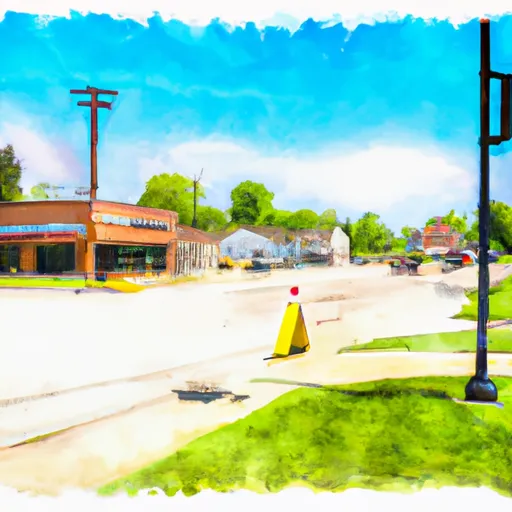-
 Snoflo Premium
Snoflo Premium
Get unlimited access to all our content
With no Ad interruptions! - Start Your Free Trial Login with existing account
Maybee
Eden Index
Climate
7.5
•
Recreation
6.0
•
Community
•
Safeguard
5.1/10

Maybee, Michigan is a small village located in Monroe County, in the southeastern part of the state. The climate in Maybee is classified as humid continental, characterized by hot summers and cold winters. Summers are typically warm and humid, with temperatures reaching the low 80s°F (27-29°C), while winters are cold with temperatures dropping to the mid-20s°F (-3 to -4°C). Precipitation is evenly distributed throughout the year, with an average of 34 inches (86 cm) annually.
The hydrology constituents in Maybee primarily consist of the River Raisin, which flows through the village. The river provides a scenic backdrop and offers opportunities for fishing and boating. Anglers can expect to catch a variety of fish species, including bass, pike, and panfish.
Outdoor recreation enthusiasts in Maybee can take advantage of the area's natural beauty. The village is surrounded by lush countryside, offering ample space for hiking, biking, and wildlife spotting. Additionally, the nearby Sterling State Park features a beach, campgrounds, and trails, making it a popular spot for swimming, picnicking, and camping.
Overall, Maybee, Michigan offers a pleasant climate, picturesque hydrology constituents, and diverse outdoor recreation opportunities for residents and visitors alike.
What is the Eden Index?
The Snoflo Eden Index serves as a comprehensive rating system for regions, evaluating their desirability through a holistic assessment of climate health, outdoor recreation opportunities, and natural disaster risk, acknowledging the profound impact of these factors on livability and well-being.
Climate Health Indicator (CHI): 7.5
Maybee receives approximately
891mm of rain per year,
with humidity levels near 80%
and air temperatures averaging around
10°C.
Maybee has a plant hardyness factor of
5, meaning
plants and agriculture in this region thrive during a short period during spring and early summer. Most
plants will die off during the colder winter months.
By considering the ideal temperature range, reliable water supplies, clean air, and stable seasonal rain or snowpacks, the Climate Health Indicator (CHI) underscores the significance of a healthy climate as the foundation for quality living.
A healthy climate is paramount for ensuring a high quality of life and livability in a region, fostering both physical well-being and environmental harmony. This can be characterized by ideal temperatures, reliable access to water supplies, clean air, and consistent seasonal rain or snowpacks.
Weather Forecast
Streamflow Conditions
Western Lake Erie
Area Rivers
Western Lake Erie
Snowpack Depths
Western Lake Erie
Reservoir Storage Capacity
Western Lake Erie
Groundwater Levels
Recreational Opportunity Index (ROI): 6.0
The Recreational Opportunity Index (ROI) recognizes the value of outdoor recreational options, such as parks, hiking trails, camping sites, and fishing spots, while acknowledging that climate plays a pivotal role in ensuring the comfort and consistency of these experiences.
Access to outdoor recreational opportunities, encompassing activities such as parks, hiking, camping, and fishing, is crucial for overall well-being, and the climate plays a pivotal role in enabling and enhancing these experiences, ensuring that individuals can engage in nature-based activities comfortably and consistently.
Camping Areas
| Campground | Campsites | Reservations | Toilets | Showers | Elevation |
|---|---|---|---|---|---|
| Metamora - Hadley Rec Area | 215 | 934 ft | |||
| Pontiac Lake State Rec Area | 175 | 1,015 ft | |||
| Highland State Rec Area | 40 | 977 ft | |||
| Wayne County Fairgrounds RV | None | 691 ft | |||
| Groveland Oaks County Park | None | 963 ft | |||
| Sterling State Park | 250 | 579 ft | |||
| Camp Dearborn | 191 | 934 ft | |||
| Seven Lakes State Park | 75 | 959 ft | |||
| Holly State Rec Area | 160 | 1,026 ft | |||
| Proud Lake State Rec Area | 130 | 1,002 ft |
Nearby Ski Areas
Catastrophe Safeguard Index (CSI):
The Catastrophe Safeguard Index (CSI) recognizes that natural disaster risk, encompassing floods, fires, hurricanes, and tornadoes, can drastically affect safety and the overall appeal of an area.
The level of natural disaster risk in a region significantly affects safety and the overall livability, with climate change amplifying these risks by potentially increasing the frequency and intensity of events like floods, fires, hurricanes, and tornadoes, thereby posing substantial challenges to community resilience and well-being.
Community Resilience Indicator (CRI):
The Community Resilience Indicator (CRI) recognizes that education, healthcare, and socioeconomics are crucial to the well-being of a region. The CRI acknowledges the profound impact of these elements on residents' overall quality of life. By evaluating educational resources, healthcare accessibility, and economic inclusivity, the index captures the essential aspects that contribute to a thriving community, fostering resident satisfaction, equity, and social cohesion.

